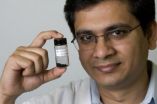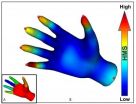(Press-News.org) WASHINGTON — Synthetic fat substitutes used in low-calorie potato chips and other foods could backfire and contribute to weight gain and obesity, according to a study published by the American Psychological Association.
The study, by researchers at Purdue University, challenges the conventional wisdom that foods made with fat substitutes help with weight loss. "Our research showed that fat substitutes can interfere with the body's ability to regulate food intake, which can lead to inefficient use of calories and weight gain," said Susan E. Swithers, PhD, the lead researcher and a Purdue psychology professor. The study was published online in the APA journal Behavioral Neuroscience.
The study used laboratory rats that were fed either a high-fat or low-fat diet of chow. Half of the rats in each group also were fed Pringles potato chips that are high in fat and calories. The remaining rats in each group were fed high-calorie Pringles chips on some days and low-calorie Pringles Light chips on other days. The Pringles Light chips are made with olestra, a synthetic fat substitute that has zero calories and passes through the body undigested.
For rats on the high-fat diet, the group that ate both types of potato chips consumed more food, gained more weight and developed more fatty tissue than the rats that ate only the high-calorie chips. The fat rats also didn't lose the extra weight even after the potato chips were removed from their diet. "Based on this data, a diet that is low in fat and calories might be a better strategy for weight loss than using fat substitutes," Swithers said. However, she warned that it can be difficult to extrapolate laboratory findings about rats to people, even though their biological responses to food are similar. The study was conducted by Swithers along with Purdue psychology professor Terry L. Davidson, PhD, and former Purdue undergraduate student Sean Ogden.
Why would a fat substitute confuse the body? Food with a sweet or fatty taste usually indicates a large number of calories, and the taste triggers various responses by the body, including salivation, hormonal secretions and metabolic reactions. Fat substitutes can interfere with that relationship when the body expects to receive a large burst of calories but is fooled by a fat substitute.
There is some good news if a diet is naturally low in fat. The rats that were fed a low-fat diet didn't experience significant weight gain from either type of potato chips. However, when those same rats were switched to a high-fat diet, the rats that had eaten both types of potato chips ate more food and gained more weight and body fat than the rats that had eaten only the high-calorie chips.
Swithers and Davidson have reported similar findings in previous rat studies that showed saccharin and other artificial sweeteners also can promote weight gain and increased body fat. The use of artificial sweeteners and fat substitutes has increased dramatically over the past 30 years, mirroring the increase in obesity in America. Dieters have turned to these artificial means to lower calories while still eating foods that taste sweet or fatty. So what is a dieter supposed to do to drop a size?
"Unfortunately, there is no silver bullet," Swithers said. "Eating food which is naturally low in fat and calories may be a better route than relying on fat substitutes or artificial sweeteners."
###
The American Psychological Association, in Washington, D.C., is the largest scientific and professional organization representing psychology in the United States and is the world's largest association of psychologists. APA's membership includes more than 154,000 researchers, educators, clinicians, consultants and students. Through its divisions in 54 subfields of psychology and affiliations with 60 state, territorial and Canadian provincial associations, APA works to advance psychology as a science, as a profession and as a means of promoting health, education and human welfare.
Article: "Fat Substitutes Promote Weight Gain in Rats Consuming High-Fat Diets," Susan E. Swithers, PhD, Sean B. Ogden, and Terry L. Davidson, PhD, Purdue University; Behavioral Neuroscience, Vol. 125, No. 4
Contact: Dr. Swithers at swithers@psych.purdue.edu or (765) 494-6279, or Amy Patterson Neubert, (765) 494-9723, apatterson@purdue.edu
END
Female bosses sometimes have a reputation for not being very nice. Some display what's called "queen bee" behavior, distancing themselves from other women and refusing to help other women as they rise through the ranks. Now, a new study, which will be published in an upcoming issue of Psychological Science, a journal of the Association for Psychological Science, concludes that it's wrong to blame the woman for this behavior; instead, blame the sexist environment.
Belle Derks of Leiden University in the Netherlands has done a lot of research on how people respond to sexism. ...
Richmond, Va. (June 20, 2011) – Researchers at Virginia Commonwealth University Massey Cancer Center have revealed novel mechanisms in mitochondria that have implications for cancer as well as many other age-related diseases such as Parkinson's disease, heart disease and hypertension. This discovery has pioneered the formation of a whole new field within epigenetics research ripe with possibilities of developing future gene therapies to treat cancer and age-associated diseases.
Shirley M. Taylor, Ph.D., researcher at VCU Massey Cancer Center and associate professor in ...
DeKalb, Ill. – Scientists at Northern Illinois University say they have discovered a simple method for producing high yields of graphene, a highly touted carbon nanostructure that some believe could replace silicon as the technological fabric of the future.
The focus of intense scientific research in recent years, graphene is a two-dimensional material, comprised of a single layer of carbon atoms arranged in a hexagonal lattice. It is the strongest material ever measured and has other remarkable qualities, including high electron mobility, a property that elevates its ...
WEST LAFAYETTE, Ind. - Two new techniques for computer-vision technology mimic how humans perceive three-dimensional shapes by instantly recognizing objects no matter how they are twisted or bent, an advance that could help machines see more like people.
The techniques, called heat mapping and heat distribution, apply mathematical methods to enable machines to perceive three-dimensional objects, said Karthik Ramani, Purdue University's Donald W. Feddersen Professor of Mechanical Engineering.
"Humans can easily perceive 3-D shapes, but it's not so easy for a computer," ...
It is a common perception that bigger, stronger, faster organisms have a distinct advantage for long-term survival when competing with other organisms in a given community.
But new research from the University of Washington shows that in some structured communities, organisms increase their chances of survival if they evolve some level of restraint that allows competitors to survive as well, a sort of "survival of the weakest."
The phenomenon was observed in a community of three "nontransitive" competitors, meaning their relationship to each other is circular as in ...
CAMBRIDGE, Mass. — In the 1983 movie "A Man with Two Brains," Steve Martin kept his second brain in a jar. In reality, he had two brains inside his own skull — as we all do, one on the left and one on the right hemisphere. When it comes to seeing the world around us, each of our two brains works independently and each has its own bottleneck for working memory.
Normally, it takes years or decades after a brand new discovery about the brain for any practical implications to emerge. But this study by MIT neuroscientists could be put to immediate use in designing more effective ...
TORONTO, Ont., June 20, 2011--Every second counts when performing CPR.
A new study has found the number of people who survive after suffering a cardiac arrest outside a hospital drops significantly if the pause between stopping CPR and using a defibrillator to administer an electric shock is longer than 20 seconds.
The number of people who survive rises significantly if the pause is less than 10 seconds.
"If your pre-shock pause is over 20 seconds, the chances of surviving to reach a hospital, be treated and be discharged are 53 per cent less than if the pause is ...
BUFFALO, N.Y. -- Frequent use of energy drinks is associated with binge drinking, alcohol-related social problems and misuse of prescription drugs among musicians, according to researchers at the University at Buffalo's Research Institute on Addictions.
In survey results published in the Journal of Caffeine Research this spring, UB research scientists Kathleen E. Miller and Brian M. Quigley examined substance use by 226 Western New York professional and amateur musicians aged 18-45. In the sample, 94 percent were caffeine users and 57 percent reported use of energy ...
Tropical Storm Beatriz developed from a low pressure area that NASA was watching last week. Beatriz is now expected to reach hurricane force and hit western coastal Mexico today and tomorrow. NASA satellite imagery today revealed powerful thunderstorms bubbling within, indicating further strengthening is occurring.
Beatriz formed from the low pressure area System 92E that NASA and JAXA's Tropical Rainfall Measuring Mission (TRMM) was watching last week. The low pressure area was coming together on Friday, June 17 and had some isolated areas of heavy rainfall. Those areas ...
The rate of sea level rise along the U.S. Atlantic coast is greater now than at any time in the past 2,000 years--and has shown a consistent link between changes in global mean surface temperature and sea level.
The findings are published this week in the journal Proceedings of the National Academy of Sciences (PNAS).
The research, funded by the National Science Foundation (NSF), was conducted by Andrew Kemp, Yale University; Benjamin Horton, University of Pennsylvania; Jeffrey Donnelly, Woods Hole Oceanographic Institution; Michael Mann, Pennsylvania State University; ...



